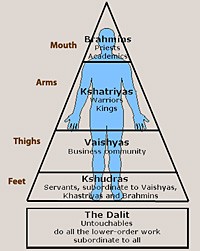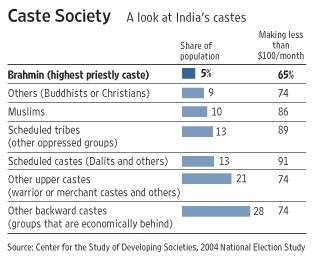04/22/2013
About casts and inequalities in India - The big picture
The system of the castes in India dates back thousands of years. Hyper complicated but also quite simple in substance.
There are 4 varnas or “families” of castes (the most famous being the upper caste of the “Brahmins”) and then the out-caste known as “untouchables” and today called "scheduled class”. The varnas, representing the 4 parts of the God Brahma’s body (see diagram), are divided into thousands of castes, called jatis, which each have a specific role (more or less a profession).
Every Hindu is born into a caste, shares its culinary habits, gets married within, and died within, hoping to get reborn in a higher caste. And people don't mix. Everyone at their place and the sheep will be well kept as we say in French...
The Indian Constitution prohibits discrimination based on caste.
That said it does not belong to the Government to abolish such a system because it is related to religion. As a matter of fact, the last census (2011) included a (optional) question about the caste.
Casteism is a pillar of Hinduism: "the fulfilment of one personal duty to the caste - and not a universal duty - and the system of reincarnation in a higher or lower caste as a reward for your good or bad actions are the two fundamental pillars of this religion until the final liberation and paradise."*). To the point that Dr. Ambedkar encouraged untouchables to convert to Buddhism in the 1950s.
To fight this discrimination, the Government has implemented quotas for access to education, civil servant positions, political seats. There even has been an untouchable president (K. R. Narayanan).
The problem is that today it is all mixed up and ultimately these quotas are based on the social status (caste) of people but not on the merit or the income. And as low and out-castes form a majority *, politicians are struggling to change this system...
Besides, in the countryside, where 70% of the population still live, the caste system is still very much alive and rigid.
As Sampat Pal says*, " India has been a free and independent country for sixty years: yet the poorest people still don’t know what it is to live in an independent country. Laws are modern, but because of an administration rife with corruption, they are not applied. In sixty years, they have brought neither social justice nor improvement in the standard of living for the poor. Their daily life has not changed one bit." As I hardly go to the country side I can’t really comment on this but every day we can read stories of girls severely injured by their own gang and/or family for having wanted to marry a man of a different caste...
* In the shoes of an untouchable, Marc Boulet
* According to the latest census (source: http://www.censusindia.gov.in/2011census) the “untouchables” and tribes account for 30% of the Hindu population / 24% of the Indian population. And if we add the "feet" (the “kshudras” or lower castes) it gives us 54% of the population.
* I, Sampat Pal, head of the pink sari gang, Sampat Pal
To be continued in the next post…
08:02 Posted in Incredible India! | Permalink | Comments (0) | Tags: india, castes, casts, caste, system, untouchability, intouchables, pariahs, pink sari gang, sampat pal, ambedkar, inequalities, poverty, discrimination | ![]() Facebook | |
Facebook | |

















The comments are closed.